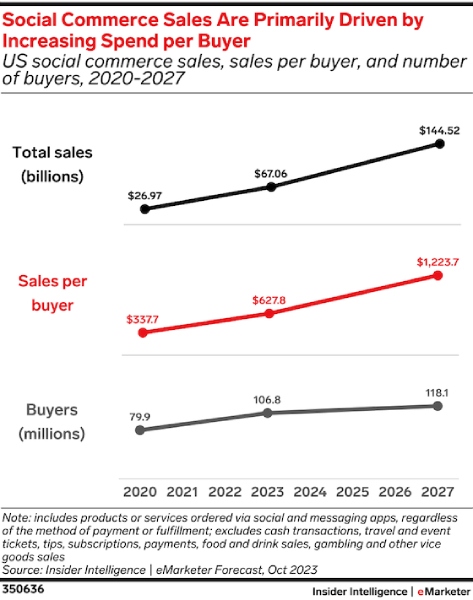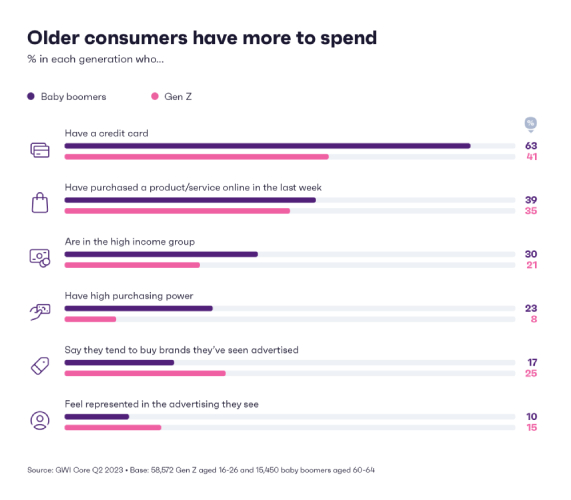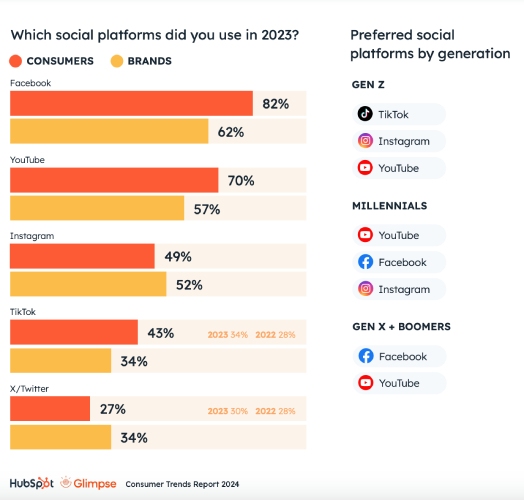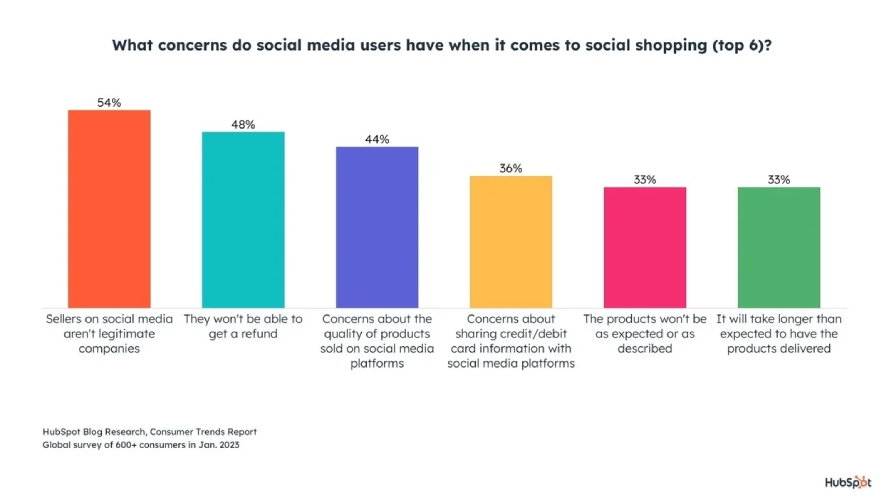It’s time to go social! Let these stats help you decide which platform to sell on and how to market your products to increase sales.
25+ Social Commerce Statistics
This article is part of a larger series on Retail Management.
Social shopping has gone mainstream. People are on their phones and scrolling on social media all the time, creating an opportunity for retailers. Social commerce has become easier and more popular—in-app purchases are increasingly common and more brands are shifting focus to their social channels to drive sales.
Let the social commerce statistics below help you craft your strategy for establishing an ecommerce presence for your brand on social media.
Key Takeaways:
- Younger generations are the driving force behind social commerce’s popularity, with 83% of those aged 16 to 24 already having shopped through social media.
- Facebook is the top social channel for selling in the US—20.6% of consumers purchase from the platform—even with TikTok’s huge surge in popularity. Consumers say the platform delivers the best shopping experience.
- Trust is still a big issue for customers when shopping on social. Concerns about brands being legit and product quality make consumers hesitant to buy.
Global Social Commerce Landscape
Social commerce is changing the ecommerce landscape. While social commerce started as a response to evolving customer behaviors, it is now an opportunity for brand awareness, marketing, and sales.
1. Approximately 62% of the population are social media users
People are on their phones all the time. As of January 2024, 5.04 billion—62%—of the world’s population are social media users.
2. Social commerce generated $571 billion in global revenue in 2023
Social commerce generated an estimated revenue of $571 billion in 2023 globally. It is forecasted to surpass the one trillion dollar mark by 2028 at an expected compound annual growth rate (CAGR) of 13.7%.
3. Three-quarters of global consumers have bought through social commerce
67% of global consumers have made a purchase through social commerce—up from 65% in 2022 and 44% in 2021—and 53% signify intent to shop more in the future. Clearly, social commerce is no longer a passing trend.
4. The majority of social commerce shoppers want to buy within apps
Over half of global consumers (53%) want to buy from within social apps and prefer not to be redirected elsewhere. Additionally, 49% say they have purchased “on the platform”—in-app purchase or within the social platform—while 26% have followed the links off the platform.
For retailers, the ability to integrate into social channels should be a key factor when deciding which ecommerce platform to go with.
What You Can Do:
Sell on social. If you haven’t already, activate in-app purchases for your social media accounts. Most social platforms offer built-in integrations with Shopify, our top pick for best ecommerce platform. You would like to go with an ecommerce platform that can automatically sync inventory when sales happen on social channels, too.
Learn how to sell on social by following our guides below:
Social Commerce in the US
The US is lagging behind its Asian counterparts, but the future of social commerce is bright. Let’s take a look at the state of social commerce in the US below.
5. The majority of Americans use social media
In the US, there are 239 million social media users, around 70% of the country’s population. 57% of US consumers have bought through social media, which is lower compared to 90% in China.
6. Social commerce sales are forecast to make up nearly 10% of all US ecommerce sales by 2027
Roughly 5% of 2022 online retail sales in the US were generated using social networks as a channel. It is expected to increase and account for 8.4% of US ecommerce sales by 2027.
In 2023, social commerce sales in the US were estimated at nearly $67.06 billion. As social media’s influence continues to increase, US social commerce is projected to reach close to $150 billion by 2027.
7. Annual spend per buyer is estimated to double by 2027
It was estimated that 106.8 million US consumers bought from social media in 2023 and the annual sales per buyer is nearly $630. By 2027, social buyers are forecast to reach 118.9 million with double an annual spend per buyer—nearly $1,225.
Interestingly, social commerce sales are rising faster than the number of social buyers, meaning sales are primarily driven by increased spend per buyer, not new buyers. This is an opportunity for retailers to turn browsers into buyers.

Source: eMarketer
8. TikTok Shop is poised to drive social commerce growth in the US
The launch of TikTok Shop in 2023 could continue to turn the tide. The US has the largest number of TikTok users worldwide, even with the potential ban of the app by the government. In fact, TikTok Shop sales are on the rise—generating $363 million in consumer spending two months after its launch.
What You Can Do:
The increasing spend per social media user in the US signifies increased confidence in social platforms as secure buying channels. Your focus should be on marketing and engagement to help convert browsers into buyers. Refer to our guides below, especially the ecommerce strategy guide for TikTok, as TikTok Shops have been experiencing high revenue sales since its launch and show no signs of slowing down.
- TikTok Ecommerce Strategy Guide
- How to Create a TikTok Marketing Strategy (+ Examples)
- Social Media Marketing for Small Business: Guide + Template
- How to Make a Social Media Plan in 5 Steps [+ Free Template]
- 8 Social Media Fails, Mistakes & Scandals (& What to Do Instead)
- Ecommerce Marketing Strategy Ideas for Retailers
Social Commerce: Demographics & Engagement
As expected, younger generations are leading the pack when it comes to social commerce, but Baby Boomers have been doing more scrolling and shopping over the years—so don’t discount them yet.
9. Millennials and Gen Z-ers are more likely to purchase via social
Millennials are the generational group with the highest adoption of social shopping. Gen Z ecommerce users followed, with over half reporting purchases through these platforms.
Among age groups, 83% of those aged 16 to 24 have shopped through social media compared to just 33% of those aged above 55. Seven out of ten online shoppers around the world between the ages of 27 and 42 had already made purchases directly through social networks as of the second quarter of 2023.
10. Baby Boomers are increasingly spending time on social media
Boomers are a lucrative and increasingly accessible market—their time spent on social has increased by 68% since 2013.
The number of baby boomers who use TikTok has grown 57% since 2021. And they’re more likely to have bought a product or service online in the last week than Gen Z.
Plus, their spending power is unmatched, compared to the younger generations. In short, they have more time to scroll and more money to spend.
11. 21% of consumers consider themselves content creators or influencers
According to the HubSpot Consumer Trends Report 2024, 21% consider themselves content creators or influencers, jumping up to 45% for Gen Z-ers and Millennials. The most surprising trend was more and more people identifying as influencers and creators with a stronger preference for trusting creators for recommendations.
12. 40% of consumers use social media to learn new things or find ideas and inspiration
The same HubSpot report shows that people’s reasons for going on social media have changed. Consumers are going to TikTok for ideas and inspiration—which wasn’t as popular in the previous years—and like the more video-centric platform YouTube, consumers are also going to social media to learn new things and find inspiration.
13. Generational cohorts vary in terms of how they purchase on social
Roughly two-thirds of millennials followed and purchased goods from brands’ social media accounts. When it comes to purchasing directly from influencers, about half of Gen Z users followed and purchased from influencers compared to just 11% of baby boomers.
Interestingly, older generations are still more likely to purchase directly from brands’ social accounts rather than an influencer’s recommendation or account. Six out of 10 respondents from the Gen X age group followed and purchased from the social media accounts of retailers.
However, we see this trend reversing in the next few years as older influencers are capturing attention—defying ageist stereotypes and inspiring even the younger generations.

Source: GWI
What You Can Do:
Develop marketing strategies catered to your target market’s generation or age group, and create content suited to the platform you are selling in. Read more about each generation’s shopping habits using our guides below:
Top & Preferred Social Commerce Platforms
Facebook still leads the pack as the preferred social commerce platform, but age groups still greatly contribute to platform usage. Gen Z-ers prefer TikTok, Millennials go for YouTube, while Gen X-ers love Facebook.
However, social media crossovers are common. For example, those who prefer Instagram are more likely to also use Pinterest, suggesting that both platforms serve as valuable resources for product discovery and inspiration.
14. Roughly a quarter of global consumers find Facebook best for social commerce
Facebook was the top social network for shopping in the US, with 20.6% of digital shoppers using it for shopping. Instagram ranked second (11.8%), followed by YouTube (10.7%).
23% of global consumers rated Facebook as the social media platform delivering the best experience for social commerce. Instagram ranked second, with 18%, followed by YouTube and TikTok, at 8% each.
15. Gen Z prefers Instagram for purchasing through social
Facebook was the most popular social media platform to purchase products for all generations except for Gen Z, who preferred using Instagram. However, Gen Z Facebook usage continues to rise on a weekly basis, increasing 15% since Q1 2021.
Gen Z shoppers also liked using TikTok for social commerce, with nearly half using the platform for purchasing products.
16. Facebook Marketplace continues to drive Facebook’s popularity among age groups
Part of Facebook’s success as a social platform can be attributed to the continued consumer presence of all age groups. Interestingly, Gen Z is still using Facebook, but not for the usual reasons—they are using the platform for Facebook Marketplace (34%), which resonates with their values of sustainability and affordability.
Across all age groups, there has been a 13% increase in the use of Facebook Marketplace or Instagram Shopping since the first quarter of 2021.
What You Can Do:
Numbers don’t lie—so, sell on Facebook. It is still the preferred social shopping app among consumers across all age groups. If you are already selling on Facebook, standing out among the competition and attracting buyers is your next task. Here are some of our guides that can help you target the right buyers on Facebook:
Social Commerce Consumer Behavior Statistics
Social media is the new search engine—it is the number one channel most age groups go to for product discovery and research. Purchasing decisions are also now based on content they see on social—mainly from influencers and other consumers.
17. One in four consumers prefer to discover new products through social media over any other channel
Social media is the number one channel for product discovery for Gen Z, Millennials, and Gen X.
Thirty-three percent of consumers in a survey done by HubSpot have discovered a new product on social media in the past three months.
18. Gen Z spends the most time on social media among all generations
Gen Z spends over three hours a day on social media, the highest among all generations. However, overall, US consumers spend 13% less time on social media per day (2 hours, 16 minutes) compared to the global average (2 hours, 34 minutes).
19. Older generations are embracing social platforms
The number of 50- to 64-year-olds with more than five social media accounts has grown by 37%, since the first quarter of 2021.
20. Short-form is the most preferred type of content
Short-form videos are the preferred type of content across all channels—and this is evidenced by most platforms providing video features after TikTok debuted with videos as the primary form of content sharing and went viral.
Of the types of content brands post on social media, 52% of consumers say funny content is the most relatable and 38% prefer “relatable” content.
Baby boomers have shown a 13% increase in discovering brands through ads on social media—traditional media marketing still captures their attention.
21. Influencer recommendations are more popular among younger generations
Gen Z-ers base purchasing decisions on influencer recommendations. Gen Zers even feel that recommendations from influencers are more important than recommendations from friends and family.
Over 20% of social media users bought a product based on an influencer’s recommendation in the past three months. And these influencers weren’t celebrities, 62% of influencers that successfully inspired a viewer to buy had under 10K followers, and 25% had under 1K.
22. Younger generations are also most likely to make impulse purchases
41% of Gen Z and millennials make an impulse purchase online every two to three weeks, rising to 48% among daily TikTok users. However, this drops to 10% among baby boomers.
23. Most consumers respond to authentic content
63% of consumers say it’s more important for marketing videos to be authentic than polished. 63% of consumers feel the content brands post on social media is authentic or relatable, with 59% saying that brand content is tailored to their interests.

Source: HubSpot
What You Can Do:
- Leverage influencer marketing. Influencers deliver referrals and partnering with them can broaden your brand reach and drive sales.
- Encourage referrals on social by motivating customers to talk about your brand and products on their feeds, such as leaving a review or sharing their shopping experience with your brand. Integrate social proof in your marketing. Learn more about user-generated content and how to use it for ecommerce.
- With product discovery happening on social, make sure to prioritize product visibility. Develop informative content for your feed by creating detailed and accurate content.
- Leverage social media ads. Paid ads still work even on social platforms.
Social Commerce Challenges
While social commerce is proving to be a game-changer in ecommerce, it still comes with challenges. As social shopping gets more popular and easier, brands need to work on building trust with their market to make them buyers.
24. 47% of social media users feel comfortable buying through social apps
This figure is an increase from 41% in January 2023. Only 45% are confident in giving social platforms their credit card information.
25. Brand legitimacy is the main reason for mistrust in social shopping
Trust is a big factor for social shopping among social media users, as 54% are concerned that companies selling on social media aren’t legitimate.
The biggest concerns consumers have around social shopping are:
- The companies aren’t legitimate.
- It will take longer than expected to arrive.
- They won’t be able to get a refund.
26. 30% of social shoppers weren’t satisfied with what they bought from social media
While over 80% of shoppers were satisfied with a recent social purchase, only about 30% felt that what they bought was “high quality.”

Source: HubSpot
What You Can Do:
- Maintain a secure and professional website. Consumers search for products on social but will always check if a brand is legit by searching for its website. Link your online store in your social accounts.
- Have an FAQ link on your profile with expected shipping times, support information, and other common concerns from new customers.
- Clearly communicate your return policy during the checkout process and post-purchase.
- Make it easy to get in touch with your team if customers have issues.
Related:
Bottom Line
The social commerce market statistics we curated clearly show that retailers should include social platforms as one (or two) of their sales channels. Marketing should also be tailored to customer preference trends, particularly among age groups.
And while social shopping has gone mainstream, it is up to retailers to earn consumer trust to convert sales. Leveraging influencers, user-generated content, and maintaining a professional website are just a few ways brands can instill trust.